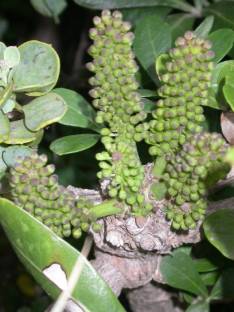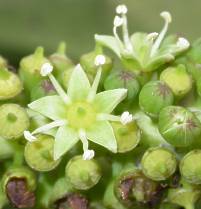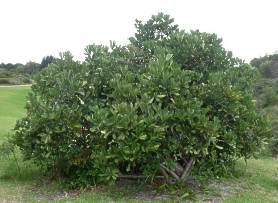Cussonia thyrsiflora
Cussonia thyrsiflora Thunb.
Family: Araliaceae
Common names: Cape coast cabbage tree (Eng.); Kaapse kuskiepersol (Afr.)
SA Tree No: 565
Introduction
This evergreen shrub or small tree is an ideal specimen to include in coastal gardens, as it is very hardy and well-adapted to dry coastal scrub. It bears yellow-green flowers, which are followed by fleshy black fruit.

Description
Description
Cussonia thyrsiflora is a dense, spreading shrub and could be considered as a small tree of 2-5 m in height and equal spread. As a tree it can form a full canopy if pruned carefully.

Leaves are composed of 6-8 palmate (arranged like a fan), glossy leaflets, 50-80 x 20-40 mm. Leaves are usually arranged at the ends of branches. The flowers are arranged in a spike of yellow-green flowers also at the ends of branches between November and January.

Spikes of purple to black berries, each about 4 mm in diameter, bear the seed from April to June. The flowers and buds appear to be waxy. The branches of this species have many leaf scars and are grey in colour and rather corky
Conservation Status
Status
Currently this species is not listed as a threatened plant. However, with ever increasing development along the southern and south-east coast of South Africa, it could make the rare and endangered list in future.
Distribution and habitat
Distribution description
Cussonia thyrsiflora is found in dry coastal thicket growing amongst species such as Sideroxylon inerme (milkwood), Chrysanthemoides monilifera (bietoubos), Rhus crenata (dune crow-berry), Metalasia muricata (blombos) and many other common coastal shrubs.
It is widespread from the Cape Peninsula to Port Elizabeth along the south-western, southern and south-east coastline of South Africa. It is well adapted to strong coastal winds and poor dune soils.
Uses
Use
The cabbage trees' roots, being tuberous and fleshy, especially those of Cussonia paniculata, C. spicata and C. thyrsiflora, have been known to be peeled and eaten as a source of food and water by the San people.
Growing Cussonia thyrsiflora
Grow
The best way to propagate this plant is by sowing ripe seed that forms on the tree by June. This should be sown in a well-drained soil and covered with a thin layer of soil. Seedlings germinate relatively easily and should be planted out into a larger container as soon as they have developed four to six leaves.

The young plant requires a well-drained soil and should be planted in full sun as an accent/focal point or as a companion plant to grow with other coastal shrubs. As this is a coastal plant, it may not be frost-hardy in inland gardens.
References
- Coates Palgrave, K. 1990. Trees of southern Africa. Struik, Cape Town.
- Goldblatt, P. & Manning, J. 2000. Cape plants. A conspectus of the Cape flora of South Africa. Strelitzia 9. National Botanical Institute, Cape Town and Missouri Botanical Garden.
- Van Wyk, B-E. & Gericke, N. 2000. People's plants. A guide to useful plants of southern Africa. Briza Publications, Pretoria.
Credits
Antonia Xaba
Harold Porter National Botanical Garden
March 2005
Plant Attributes:
Plant Type: Shrub, Tree
SA Distribution: Eastern Cape, Western Cape
Soil type:
Flowering season:
PH:
Flower colour: Green, Yellow
Aspect: Full Sun
Gardening skill:
Special Features:
Horticultural zones








Rate this article
Article well written and informative
Rate this plant
Is this an interesting plant?
Login to add your Comment
Back to topNot registered yet? Click here to register.